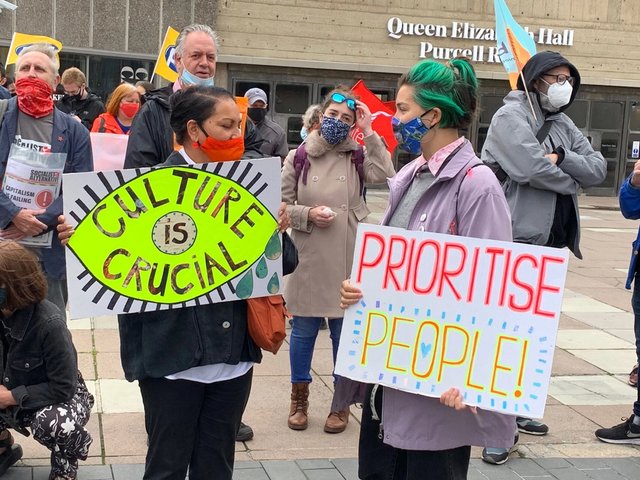Why are some organisations worth saving and others not, post the ravages of Covid-19? A software tool, Spotlight, developed by the Tory MP Michael Gove’s office—which claims to bring “greater confidence, efficiency and speed to decision-making”—has been used to vet applications for the government’s Covid-19 Cultural Recovery Fund, so far helping to allocate more than £1bn of the £1.57bn pot. But this algorithm-based approach seems to have left many struggling arts organisations out in the cold.
The main bodies charged with overseeing the process—Arts Council England (ACE), the National Lottery Heritage Fund (NLHF) and Historic England (HE)—confirmed they used Spotlight, which was introduced last summer across government departments issuing Covid-19 bailouts. The software is an “online due diligence tool for use before and during the grant application… to assure those receiving the grants are, for example, legitimate and financially sound”, according to a letter written in February by John Manzoni, the then Cabinet Office secretary. “It will do in minutes what would typically take days or weeks.”
The software may weed out fraudulent applications and save administrators time, but its role in what should be a thoughtful and complex decision-making process has raised questions over a perceived lack of transparency in how the emergency cultural funds have been awarded. Eyebrows were raised, for example, when the immersive movie experience Secret Cinema was awarded £977,004 and the well-endowed Blenheim Palace received £1.8m, while the Royal Academy of Arts (RA) was left empty-handed.
Liz Hill, of the Arts Professional website, which broke the Spotlight story, says: “If the government thinks [computer]-based grant decision-making is the way to go, then the sector should be scared—very scared.”
One of Spotlight’s main functions is to determine if “a company is showing financial weakness”; a key criterion for receiving the funds is that organisations must prove they were stable pre-Covid but are no longer trading viably by the end of this financial year.
Several unsuccessful applicants say they were ineligible because they could not prove they would be insolvent by the end of March 2021. A spokesman for the RA, which was rejected for a grant, says: “Although we are in very serious financial difficulties, we are not at this time at risk of bankruptcy within the next six months. We were, of course, aware of this beforehand and applied under the criterion to help compensate redundancy costs.”
The RA is understood to have reserves, which, according to a source close to the process, precludes them from receiving emergency funds, “even where they have expended part of their original reserves” (the RA declined to disclose the value of its reserves). But, in order to survive, the RA has to make savings of £8m, 50% of which it says will come from 100 redundancies. As an independent charity, the RA does not receive public funding.
However, the source close to the process points out that the £1.57bn cultural recovery fund “is one of the very few special funds created by government to support a sector (the Sport Fund announced recently is only £300m-£400m)”. They add: “Treasury cannot be seen to use public money to restore reserves to their pre-pandemic levels, desirable though that may be.” ACE additionally awarded £160m in emergency response funds at the start of the pandemic in March, which are separate from the £1.57bn cultural recovery fund.
Nonetheless, the artist and Royal Academician, Bob and Roberta Smith says it was “short-sighted and reckless to create criteria for support which excluded institutions like the RA”. He believes London institutions “have been left out in the cold”, adding: “In the ongoing crisis… people have deserted central London, leaving its cultural institutions high and dry.” According to the Department for Digital, Culture, Media and Sport, nearly 70% of ACE’s £500m in grants has been awarded to recipients outside of London.
ACE and NLHF criteria also stipulate that organisations considering applying must have “credible, cost-effective plans for using the award for the period 1 October 2020-31 March 2021” and be able “to demonstrate that their organisation is culturally significant and/or contributes to providing cultural opportunity in England”. The grants can be used to cover redundancy pay-outs.
In addition, ACE imposed a number of conditions, including a pay freeze on staff for at least 18 months and a 10% pay cut for those earning more than £150,000 a year; a commitment to increase diversity both in terms of staff and audiences; and a pledge to reach net zero greenhouse gas emissions by 2050.
‘Beyond a scandal’
Other major London institutions including the Barbican and the Serpentine Galleries did not apply for government funding. A spokeswoman for the Barbican says that its principal funder, the City of London Corporation, is helping it cover Covid-related shortfalls. The directors of the Serpentine Galleries declined to comment on why they were advised by ACE not to apply.
The bulk of money for building projects (more than 75%) also went to organisations outside of London, with £107m in capital grant funding awarded to 260 projects.
Not all London institutions lost out, however. In terms of grants, £1.75m went to the London Transport Museum, £1.4m to Dulwich Picture Gallery, and £3m to the Design Museum, despite its pre-Covid instability. The Southbank Centre, which has historic debts of £21m and has lost around half of its staff (though some may now be re-engaged), secured a £10.9m loan, according to an ACE announcement last month. In total, 11 organisations across England are set to receive £165m under the Repayable Finance scheme, including the UK heritage body Historic Royal Palaces, which secured a £40m loan.
There were significant boosts to smaller and regional organisations, too. Blenheim Palace in Oxfordshire, a Unesco World Heritage site, received a £1.8m grant from the NLHF, part of which will be used to create a new exhibition on former UK prime minister Winston Churchill who was born there. But one leading British cultural figure says: “It’s beyond a scandal. It’s a huge estate worth millions.” Critics say an exhibition on Churchill may be a crowd-pleaser but is out of step with the current moment.
Other regional winners include the Black Country Living Museum Trust in the West Midlands which received £2.6m; the Ironbridge Gorge Museum Trust (£1.9m); Shakespeare Birthplace Trust (£3m); and the Blackpool Tower Ballroom which was granted £764,000. The Church of England received £10m from Historic England.
Such substantial investment will no doubt be welcome but whether the Cultural Recovery Fund will sustain museums and galleries peering down the barrel of 2021 remains to be seen. “The real issue is what happens beyond March, funding wise,” says a leading museum director.




